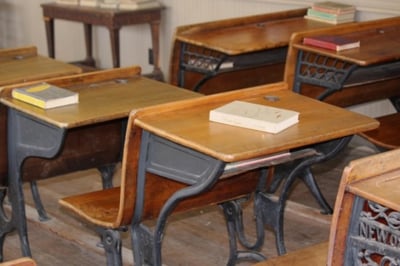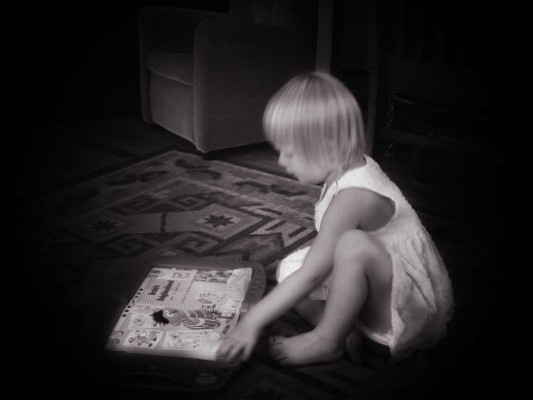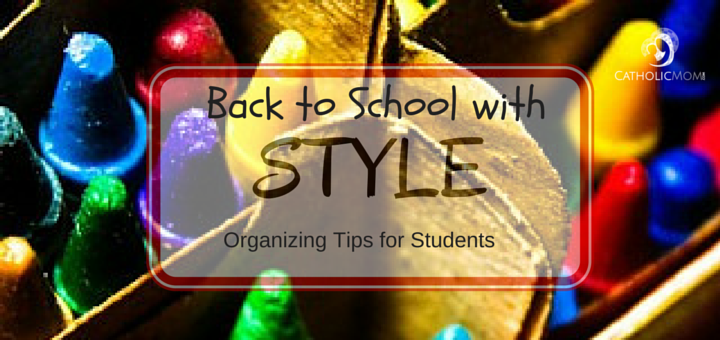When my daughter was in elementary school, she wanted a desk that would fit in the corner of her playroom. We found one that fit the space, and although it offered no drawers, it had nooks and crannies to stash things in. She worked at the desk once or twice before she chose the wide open spaces of the dining room table instead. Shortly thereafter, the desk became a dumping ground for various and sundry items that needed to be put away in the playroom. A few years later, the desk was de-cluttered (it's amazing how much stuff can be crammed into those nooks and crannies, not to mention the containers we'd added for storage) and broken down, and the space was reclaimed.
My daughter is now a senior in high school. A few years ago, she wanted a desk for her bedroom. We ended up with a desk that was similar in design to the one we'd gotten before (table top, no drawers, shallow shelves instead of nooks and crannies), but this one fits below the window in her bedroom, not in a corner. Applying the lessons she learned from her experience with the corner clutter-catcher desk from elementary school (not to mention a decade of additional maturity), she not only uses this desk daily, but also keeps it organized. The containers housing supplies are kept to a minimum, and her graduation from paper and pencil to a laptop has helped define the type of desk she wants, as well as how she uses it.
So have her styles.
 Photo: Sgarton via Morguefile
Photo: Sgarton via Morguefile
When we buy furniture for our kids, we take a lot of factors into account -- things like price, size and design, for example -- but we often buy these things before we have an awareness of our kids' styles. Not surprisingly, desks that don't match their styles tend to become ignored as workspaces. We become frustrated because we "paid good money" for a surface that collects dust and junk instead of books and homework, and our kids become frustrated because homework is a big enough chore without adding the annoyance of an uncomfortable workspace.
As a new school year begins, perhaps it's a good time to ask this question: How does your child work best?
- Does she need enough space to separate projects by class or subject? This is often the case for I need to see it and I love to be busy kids. Cram and jam kids may need only sufficient space -- enough that papers don't get crushed and crinkled. Is it any surprise these kids end up at the kitchen table?
- Does he work better if the workspace allows for only one task at a time? This may be less a matter of style and more a matter of temperament; kids who struggle to stay focused and/or stress out over what remains to be done often do better with smaller workspaces that allow them to concentrate on only the task at hand.
- Does she need a place to stash the things she's not working on now, but will need later? Drop and run kids may be more picky about the surroundings than the workspace itself. Or you may be picky about their choice of location because they're perfectly happy dropping their stuff on the floor and creating a trail to their chosen workspace.
- Does he need to work at the same spot consistently? Once a workspace is set up, the I know I put it somewhere organizer may want to work there regularly because he knows where everything is. Less time spent looking for stuff means less time spent on homework as well.
- Is she more comfortable working in a space that's been personalized? More likely to relax when surrounded by a few of her favorite things? This may be true for the I love stuff kid. One word of caution, though: if your I love stuff kid also has trouble focusing, you may need to set a limit on the number of distracting items in the immediate workspace.
Myriad other personality traits factor into choice of workspace, but if you can find a match between the organizational style and the work surface, you can build up from there.
And if the workspace of choice is the family room floor, you've got literally nowhere to go but up.
 Photo: bluekdesign via Morguefile
Photo: bluekdesign via Morguefile
Copyright 2015 Lisa Hess
Logo background image: "Unageek color" by Unageek (2013) via Morguefile. Text added in Canva.
About the Author

Lisa Hess
Transplanted Jersey girl Lisa Lawmaster Hess is the author of a blog compilation, three novels, and three non-fiction books, including the award-winning Know Thyself: The Imperfectionist’s Guide to Sorting Your Stuff. A retired elementary school counselor, Lisa is an adjunct professor of psychology at York College of Pennsylvania. She blogs at The Porch Swing Chronicles, Organizing by STYLE, and here at Catholicmom.com. Read all articles by Lisa Hess.



.png?width=1806&height=731&name=CatholicMom_hcfm_logo1_pos_871c_2728c%20(002).png)
Comments